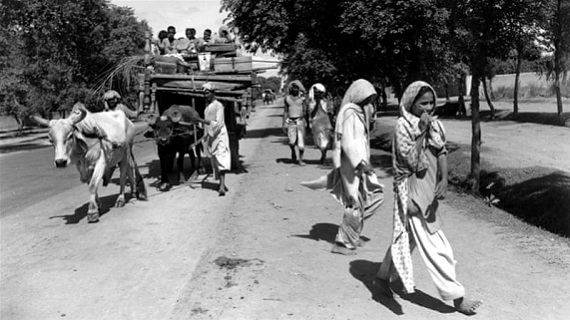Political News
Jammu Massacre: The Horrifying Event That Ignited Decades Long Kashmir Standoff
November 9, 2017 | By Sikh Siyasat Bureau
Srinagar: The family of Israr Ahmad Khan lived through the massacre of Jammu in what was then part of the princely state of Kashmir. He recalls that many of his relatives were killed during the violence that followed months after British rule over Indian sub-continent ended.
“My father was young then and other immediate family members were in Kashmir at that time. But many of my relatives were brutally killed,” said Israr Ahmad Khan while interacting with the media.
“To be honest that was a mad period. There was no humanity shown at that time,” Khan, who retired as senior police officer, said.
In November 1947, thousands of Muslims were massacred in Jammu region by mobs and paramilitaries led by the army of Dogra ruler Hari Singh.

Thousands of Muslim family fled from India after violence erupted between Hindus and Muslims after partition of the country. (Photo By Al Jazeera)
The exact number of casualties in the killings that continued for two months is not known but estimates range from 20,000 to 237,000 and nearly half million forced into displacement across the border into the newly created nation of Pakistan and its administered part of Kashmir.
“The incident divided families. There were a lot of Muslims in Jammu but now you won’t find many,” he further said.
The killings took place when millions of Muslims, Hindus and Sikhs were crossing the border from the one side to the other, as part of British-designed plan to partition the subcontinent into India and Pakistan.
“The immediate impact (of partition) was in Jammu. The Muslim subjects from different parts of Jammu province were forcibly displaced by the Dogra Army in a programme of expulsion and murder carried out over three weeks between October-November 1947,” Idrees Kanth, a fellow at International Institute of Social History in Amsterdam, who researched the 1940s history of Kashmir, told an International media outlet.
In mid-October, the Dogra Army troops began expelling Muslim villagers from Jammu province. The refugees were sent on foot toward West Punjab (later to form part of Pakistan), where most were accommodated in refugee camps in the districts of Sialkot, Jhelum, Gujrat and Rawalpindi.
On November 5, Kanth said, the Dogra Army soldiers began another organised evacuation of the Muslims but “instead of taking them to Sialkot, as they had been promised, the trucks drove them to forest hills of Rajouri districts of Jammu, where they were executed”.
There may have been a systematic attempt by the dying Dogra regime to ensure that records of the incident are destroyed and made it a lesser known massacre of the partition, Idrees Kanth further adds.
‘Demographic Changes’
The historians say that the killings carried out by the Hindu ruler’s army and Sikh army was a “state sponsored genocide” to bring out demographic changes in Jammu – a region which had an overwhelming population of Muslims.
“The massacre of more than two lakh (two hundred thousands) Muslims was state-sponsored and state supported. The forces from Patiala Punjab were called in, RSS (a pro-hindutva organisation) was brought to communalise the whole scenario and kill Muslims,” said PG Rasool, the author of a book The Historical Reality of Kashmir Dispute.
The Muslims, who constituted more than 60 percent of the population of Jammu region, were reduced to a minority after the killings and displacement.
He said that when the then Indian Prime Minister of India Pandit Jawahar Lal Nehru and Kashmiri leader Sheikh Abdullah met a delegation of Muslims in Jammu, they were told about the “tragic events” but they preferred to remain silent.
“They didn’t want that people in Kashmir – which had a Muslim majority from the beginning – should know about it because it could have led to demonstrations. The state from the beginning has tried to cover up it. I don’t call it massacre but it was a staged genocide that is unfortunately not talked about,” he further adds to his statement.
Muslims of Jammu “do not talk about it because they fear for their survival” said Muhammad Ashraf Wani, a professor of History at the University of Kashmir.
“This is the worst tragedies in the history of Kashmir but unfortunately no one talks about it because the state doesn’t want anyone to remember it,” he said.
Khurram Parvez, a noted human rights defender in Kashmir, told Al Jazeera that the perpetual conflict in Kashmir has its roots in 1947 massacre. “It is deliberately forgotten. Actually, the violence of that massacre in 1947 continues. Those who were forced to migrate to Pakistan have never been allowed to return,” he adds.
Five days after the Jammu killings, tribal militias from Pakistan’s North Western Frontier Province (now Khyber Pakhtunkhwa), where many of the Jammu Muslims had family ties, invaded Kashmir.
As the army of tribesmen rushed to Kashmir, the army of Dogra monarch fled to Jammu. The king Hari Singh signed the instrument of accession with New Delhi, which sent its army to fight the tribesmen.
The fighting of several weeks between tribesmen and Indian Army eventually led to first India-Pakistan war. When New Delhi and Islamabad agreed to a ceasefire in January 1948, the formerly princedom of Jammu and Kashmir was divided between the two countries, reports Al Jazeera.
To Get Sikh Siyasat News Alerts via WhatsApp:
(1) Save Our WhatsApp Number 0091-855-606-7689 to your phone contacts; and
(2) Send us Your Name via WhatsApp. Click Here to Send WhatsApp Message Now.
Sikh Siyasat is on Telegram Now. Subscribe to our Telegram Channel
Related Topics: Indian Politics, Indian State, Jammu and Kashmir, Jammu Massacre, Kashmir, Kashmir Agitation, Kashmir Conflict, Kashmir Crisis, Kashmir Issue, Kashmir Killings, Kashmir News, Kashmir Protests, Kashmir Unrest




